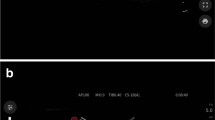Abstract
Purpose
The caudal epidural space is a popular site for analgesia in pediatrics. High variation in blind needle placement is common during caudal epidurals, increasing the risk of intravascular and intrathecal spread. Knowledge of safe distances and angles for accessing the caudal epidural space in premature infants can improve the safety of caudal epidural blocks.
Methods
Thirty-nine fetuses with crown–heel length between 33 and 50 cm, corresponding to gestational age of 7–9 months, were included. The dorsal surface of the sacrum from the fourth lumbar vertebra to the tip of the coccyx was dissected, following which measurements were taken on dorsal surface and midsagittal sections. The angle of depression of the needle was measured using a goniometer following the two-step method of needle insertion.
Results
Right and left sacral cornua were palpable in 23 of 39 fetuses (58.97%). Termination of dural sac was at S2 in most of the fetuses (53.84%), whereas the apex of the sacral hiatus was at S3 in most (58.97%). The distance from the apex of the hiatus to the termination of dura ranged from 3 to 13 mm; the anteroposterior distance of the canal at the apex of the hiatus ranged from 1.72 to 4.38 mm. All sacral parameters correlated with crown–heel length except inter-cornual distance, depth of canal at hiatus, and height of sacral hiatus.
Conclusion
Distances and angles for accessing the caudal epidural space in fetuses do not provide all parameters for safe performance of caudal epidural blocks in premature and low birth weight infants because the apex of the sacral hiatus and the termination of the dura show wide variation in location.




Similar content being viewed by others
References
Najman IE, Frederico TN, Segurado AV, Kimachi PP. Caudal epidural anesthesia: an anesthetic technique exclusive for pediatric use? Is it possible to use it in adults? What is the role of the ultrasound in this context? Rev Bras Anestesiol. 2011;61:95–109.
Hoelzle M, Weiss M, Dillier C, Gerber A. Comparison of awake spinal with awake caudal anesthesia in preterm and ex-preterm infants for herniotomy. Paediatr Anaesth. 2010;20:620–4.
Brenner L, Kettner SC, Marhofer P, Latzke D, Willschke H, Kimberger O, Adelmann D, Machata AM. Caudal anaesthesia under sedation: a prospective analysis of 512 infants and children. Br J Anaesth. 2010;104:751–5.
Bouchut JC, Dubois R, Foussat C, Moussa M, Diot N, Delafosse C, Claris O, Godard J. Evaluation of caudal anaesthesia performed in conscious ex-premature infants for inguinal herniotomies. Paediatr Anaesth. 2001;11:55–8.
Lönnqvist PA. Is ultrasound guidance mandatory when performing paediatric regional anaesthesia? Curr Opin Anaesthesiol. 2010;23:337–41.
Senoglu N, Senoglu M, Oksuz H, et al. Landmarks of the sacral hiatus for caudal epidural block: an anatomical study. Br J Anaesth. 2005;95:692–5.
Park JH, Koo BN, Kim JY, Cho JE, Kim WO, Kil HK. Determination of the optimal angle for needle insertion during caudal block in children using ultrasound imaging. Anaesthesia. 2006;61:946–9.
Adewale L, Dearlove O, Wilson B, Hindle K, Robinson DN. The caudal canal in children: a study using magnetic resonance imaging. Paediatr Anaesth. 2000;10:137–41.
Lederhass G. Spinal anaesthesia in paediatrics. Best Pract Res Clin Anaesthesiol. 2003;17:365–76.
Craven PD, Badawi N, Henderson-Smart DJ, O’Brien M. Regional (spinal, epidural, caudal) versus general anaesthesia in preterm infants undergoing inguinal herniorrhaphy in early infancy (review). Cochrane Library 2009;4.
Barham G, Hilton A. Caudal epidurals: the accuracy of blind needle placement and the value of a confirmatory epidurogram. Eur Spine J. 2010;19:1479–83.
Aggarwal A, Kaur H, Batra YK, Aggarwal AK, Rajeev S, Sahni D. Anatomic consideration of caudal epidural space: a cadaver study. Clin Anat. 2009;22:730–7.
Afshan G, Khan FA. Total spinal anaesthesia following caudal block with bupivacaine and buprenorphine. Paediatr Anaesth. 1996;6:239–42.
Porzionato A, Macchi V, Parenti A, De Caro R. Surgical anatomy of the sacral hiatus for caudal access to the spinal canal. Acta Neurochir Suppl. 2011;108:1–3.
Dalens B. Caudal anesthesia. In: Dalens B, editor. Regional anaesthesia in infants, children, and adolescents. Baltimore: Williams & Wilkins; 1995. p. 178–81.
Shin KM, Park JH, Kil HK, et al. Caudal epidural block in children: comparison of needle insertion parallel with caudal canal versus conventional two-step technique. Anaesth Intensive Care. 2010;38:525–9.
Ivani G. Caudal block: the ‘no turn technique’. Paediatr Anaesth. 2005;15:83–4.
Aggarwal A, Aggarwal A, Harjeet, Sahni D. Morphometry of sacral hiatus and its clinical relevance in caudal epidural block. Surg Radiol Anat. 2009;31:793–800.
Sekiguchi M, Yabuki S, Satoh K, Kikuchi S. An anatomic study of the sacral hiatus: a basis for successful caudal epidural block. Clin J Pain. 2004;20:51–4.
Acknowledgments
The authors wish to thank Mr. Vijay Bakshi, senior artist of the department of anatomy for art work.
Conflict of interest
The authors have no conflicts of interest.
Author information
Authors and Affiliations
Corresponding author
About this article
Cite this article
Aggarwal, A., Sahni, D., Kaur, H. et al. The caudal space in fetuses: an anatomical study. J Anesth 26, 206–212 (2012). https://doi.org/10.1007/s00540-011-1271-8
Received:
Accepted:
Published:
Issue Date:
DOI: https://doi.org/10.1007/s00540-011-1271-8




